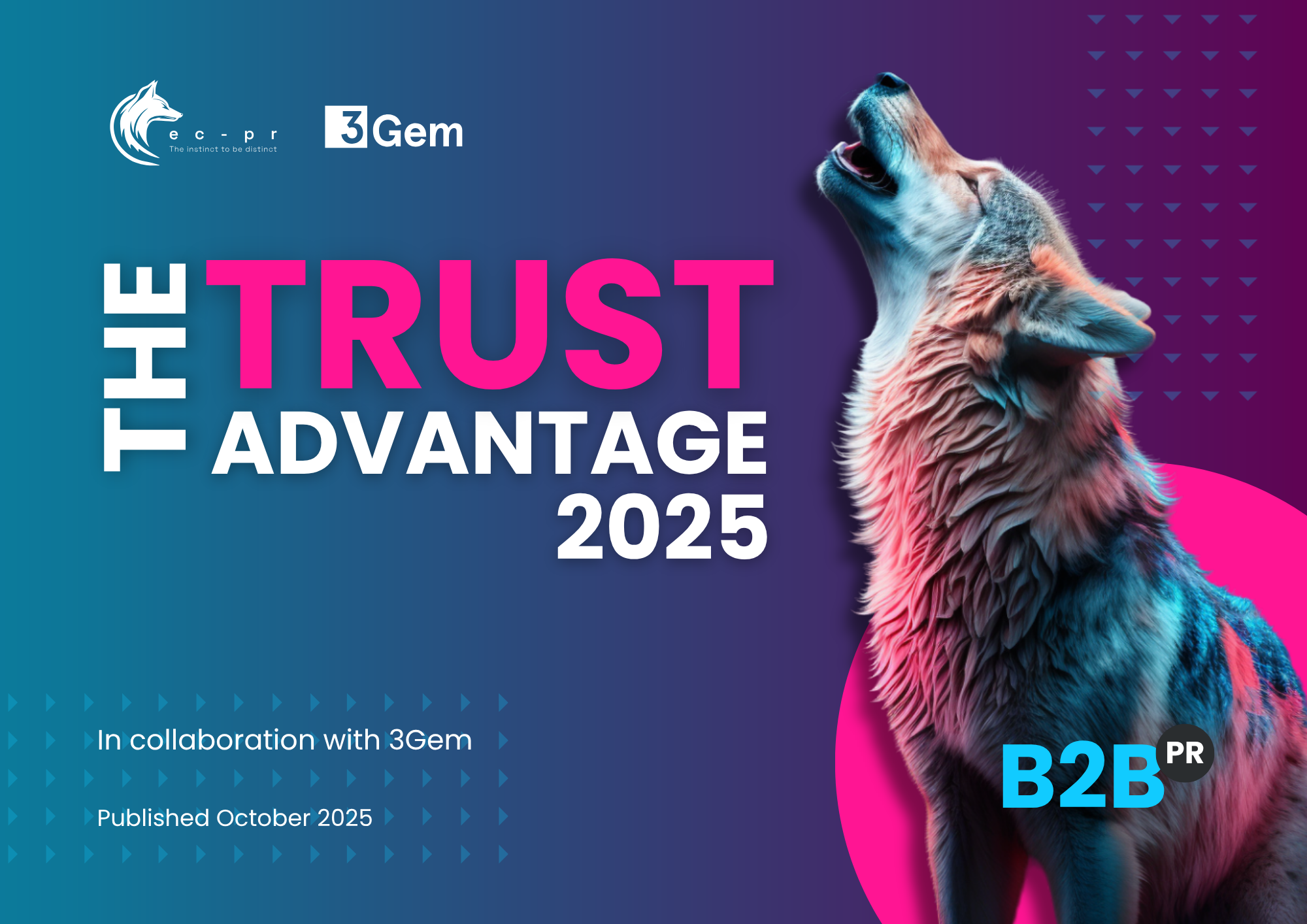
SMART PR: Measurable PR Objectives for Success
In PR, we have the power to change people’s attitudes and behaviours in strategic ways. There’s nothing like it! But what’s the use of all this power, if you don’t properly measure its effectiveness?
So, in this article, we are going to explain how to set strategic PR goals and objectives, with SMART PR examples and a mini-case study.
Why you need to set PR goals
Your PR goals might be to persuade the public to adopt more ecological habits; to advance an organisations’ mission; or to boost the growth of an ideology.
Whatever your mission, PR has potential to impact metrics that the revenue team will love:
- brand awareness
- trust and familiarity
- leads
- sales
- advocacy
This potent combination opens the door for commercial conversations.
Sounds great, right?
All the above is, of course, desirable, when measured well. It is only possible to iterate and improve over time, and to expand on what works, when measuring PR success using SMART targets.
SMART targets must be:
1. Specific
2. Measurable
3. Attainable
4. Realistic
5. Timebound
Sadly, our team at EC-PR has been called in to pick up the pieces after promising PR and communications leaders, who had what looked like a solid PR plan, but in fact was a list of tactics and campaigns, with no SMART objectives in place.
Indeed strategic, business-focused PR objectives are often absent or ill-defined. If PR goals are absent, you are missing a critical opportunity to tie PR efforts to what matters most to your boss or your client – business goals and revenue – not to mention a chance to measure success across multiple areas like messaging, audience refinement and market receptibility.

GOST with intention: PR goals vs PR objectives
A problem we run into a lot, not only when measuring PR success and shortcomings, is a pervasive and widespread confusion between Goals, Objectives, Strategy and Tactics (GOST). Although each element of GOST fundamentally refers to “what you want to achieve”, the difference between the terms is critical. Each one plays a different role in mapping out your plan, so getting them right drives precision and clarity.
A goal is an abstract vision.
Broader than the objective, a goal is typically longer term or indefinite, and focuses on an organisation’s reputation or positioning.
For example: To be the leading global provider of high-tech security services.
Smart goals accelerate business, SMART objectives drive revenue
Objectives are measurable outcomes. They trace the steps towards realising your goal. PR objectives must be shorter-term and time sensitive to motivate and be measurable too. We will always recommend using the SMART approach (Specific, Measurable, Attainable, Realistic and Timebound) because it pushes companies to consider what they hope their target audience will think, feel, and do when exposed to a given campaign.
Examples of SMART PR objectives
E.g. “We will be perceived as the global leader by 70% of customers and prospects in 12 months time, as measured by analyst reports in the field, and the local leader by 90% of the same audience.”
E.g. “Within the next 12 months, to increase the engagement rate on our social media platforms by 50%, as measured by likes, shares, and comments, and achieve a 40% growth in our follower base among industry professionals and influencers.”
Strategy is how you realise your PR objectives
A strategy is an approach that moves you from where you are now to where you want to be. These are the guiding principles for everything you do, that gives you a roadmap on how to realise your PR objective. Wider than tactics, your strategy still needs to be SMART.
Examples of SMART PR strategies
E.g. “To position the company as an authoritative voice on the subject of consumer privacy and our leaders as trustworthy advisors on the subject, as measured by organic invitations to speaking and collaborative events in 2025-6.”
E.g. “Develop and execute a comprehensive content marketing campaign that includes publishing at least 12 high-quality whitepapers and case studies on industry trends and best practices in cybersecurity over the next 12 months, with the goal of increasing website traffic by 40% and generating a 25% increase in qualified leads, as measured by web analytics and lead tracking systems.”
Tactics are a PR to-do list.
Specific and measurable, tactics focus on the efforts required to achieve your objectives and goals. Crucially, they must align with your strategy.
Examples of PR tactics
E.g. “To place our C-suite executives as speakers at five leading industry events we identified as influential; publish 12 op-eds on key industry issues in respected news sources; to develop an evergreen research report that can display the depth of our investigation, etc.”
E.g. “Launch a targeted influencer engagement programme to establish partnerships with ten key industry influencers over the next 12 months. This will involve co-creating at monthly pieces content, such as podcasts, webinars, and video interviews, to be shared across both our and the influencers’ platforms.”

Measuring PR success to shore up budgets
Good PR measurement proves its value to revenue leadership. This is not rocket science but it merits repeating because few people seem to act on their knowledge of the importance of PR objectives.
Once you have those SMART PR objectives in place, with a powerful goal as the driving force, the next step is to make sure you can measure what’s working and what’s not.
How to measure PR effectiveness
As we explain on our PR Measurement Service page, firstly, a good PR agency will measure the quantity and quality of PR outputs it makes on your behalf; we’re talking posts, articles, placements, interviews in target publications etc.
Secondly, we look at PR outcomes. There are data that we can measure easily enough depending on platform, e.g. LinkedIn, and other owned media, where we can track engagement and interactions online. However, PR is, by its nature, also offline and in earned media – third party websites and publications that we cannot easily get stats from.
So let’s start looking at the low hanging fruit of owned media and social media:
- Impressions
- Engagement (likes, shares, comments etc.)
- Open and click rates (mailings)
- Event attendance
- Unique visitors to website (tracked where possible)
Secondly, we can measure what moves the earned media needle:
- Publicity volume
- Media coverage and media reach
- Share of Voice (SoV)
- The results of sentiment analysis
And finally, metrics that makes sales teams happiest, such as:
- Registrations
- Leads
- Brand preference
- Sales
We hear you ask, “if these metrics are the bees knees, why don’t all PR agencies use them to measure PR effectiveness?” The answer is: They are hard to measure and they take time! Outputs and outcomes are possible to measure in a shorter timeframe, uplift in sales and brand preferences (leading to shorter sales lead-times and higher margins) will take much longer to determine.
We use tools that can give you varied PR insights, but if we haven’t made it clear already: the measurement of PR objectives must be SMART, and the first word of that is specific. If you work with estimates that are a little off, that could not only make measuring your PR success difficult, you could lose the trust of any superiors holding the purse strings.
The holy grail of PR measurement success
If you can answer this question, you’ll be able to set the SMARTest objectives and strategy:
What does my ideal customer need?
When your PR answers the questions of your ideal customer profile or ICP, assuages their concerns, and connects with them on a molecular level, they will buy as soon as they are ready.
The way to achieve this is by having clear and consistent messaging at the heart of everything you do, so that absolutely any PR agency, outsourced media buyer, freelance content writer, right down to your summer interns, knows how to talk about your company in a way that gives customers what they need.
How SMART PR works in practice
To exemplify all of the above, here is the story of a company that understood what their ICP needs, then nailed their SMART PR strategy and, consequently, raised revenue by 16% in three months.
[This story has been simplified for the purposes of this post and remains anonymous.]
A Fintech with a strong visual identity, and talented founders at the helm, was solving a crucial problem: Reaching the unbanked with an easy-to-use mobile app.
To build an outstanding PR strategy, first, they identified the emotional and also very practical need they were solving: People needed to receive payments in order to enter the gig economy online.
Their business goal was to spread the word on how they solve this need. Their PR strategy was:
“To establish their founders as leading experts on the local gig economies, to discuss the financial challenges of the young gig worker audience, and raise awareness of the app as a leading, easy solution for workers to get paid quickly online.”
This was distilled into these PR tactics
- Be featured once a month in four hyper local print newspapers they had identified as being read by people under 30.
- Position their founders on regional radio stations to offer financial advice, not sell their product, to entrepreneurs.
- Reiterate their mission to boost entry to the gig economy and empower young workers in every piece of PR.
As a result, they were able to set a roadmap to building close relationships with local news outlets, radio stations, and presenters, in order to begin securing spots.
Admittedly, in the first three months, they did not achieve their monthly targets, but their efforts gained momentum such that after six months, they had met every important PR objective they had set, plus those of the previous quarter.
This story shows the power of smart PR, backed by SMART objectives.
If you’re intrigued to learn more about PR for technology companies, and especially start tracing your roadmap to success, see our 8-step communication strategy guide.

The Trust Advantage
What really makes buyers say yes?
Half of B2B decision-makers rank trust above price, innovation and delivery.
Get The Trust Advantage report and stop trust gaps from costing you deals.

The Trust Advantage
What really makes buyers say yes?
Half of B2B decision-makers rank trust above price, innovation and delivery.
Get The Trust Advantage report and stop trust gaps from costing you deals.
Subscribe to our updates
Stay up to date with the latest insights, case studies and PR guides.

